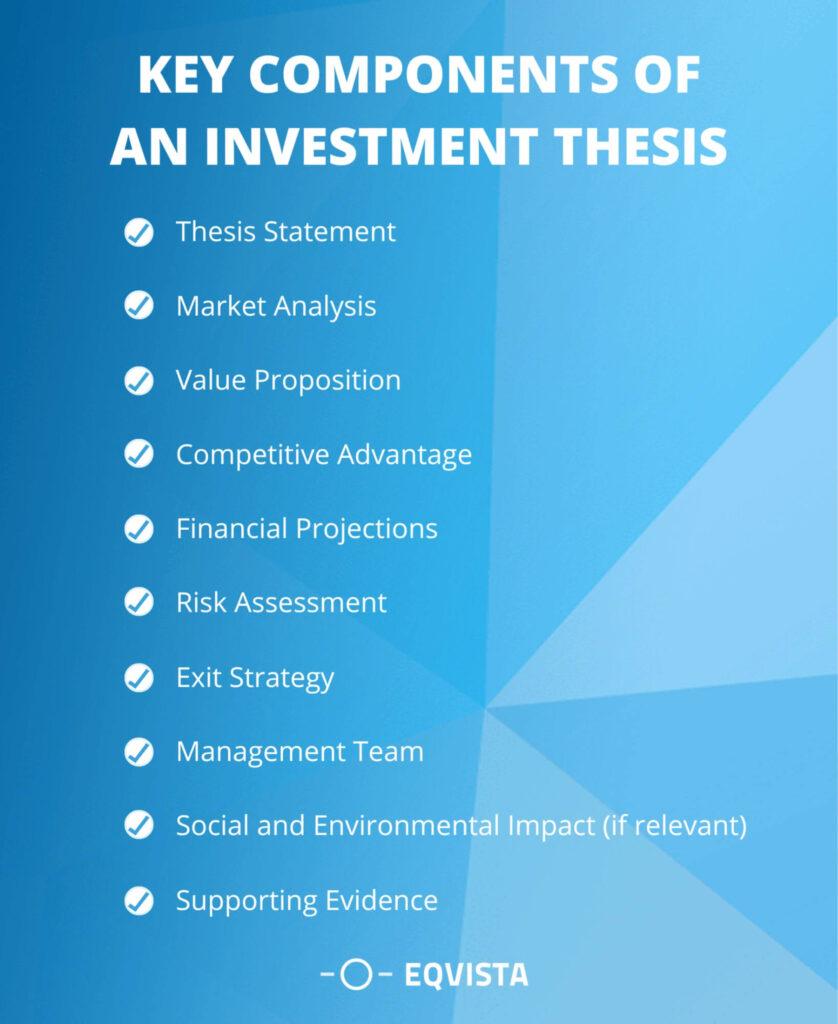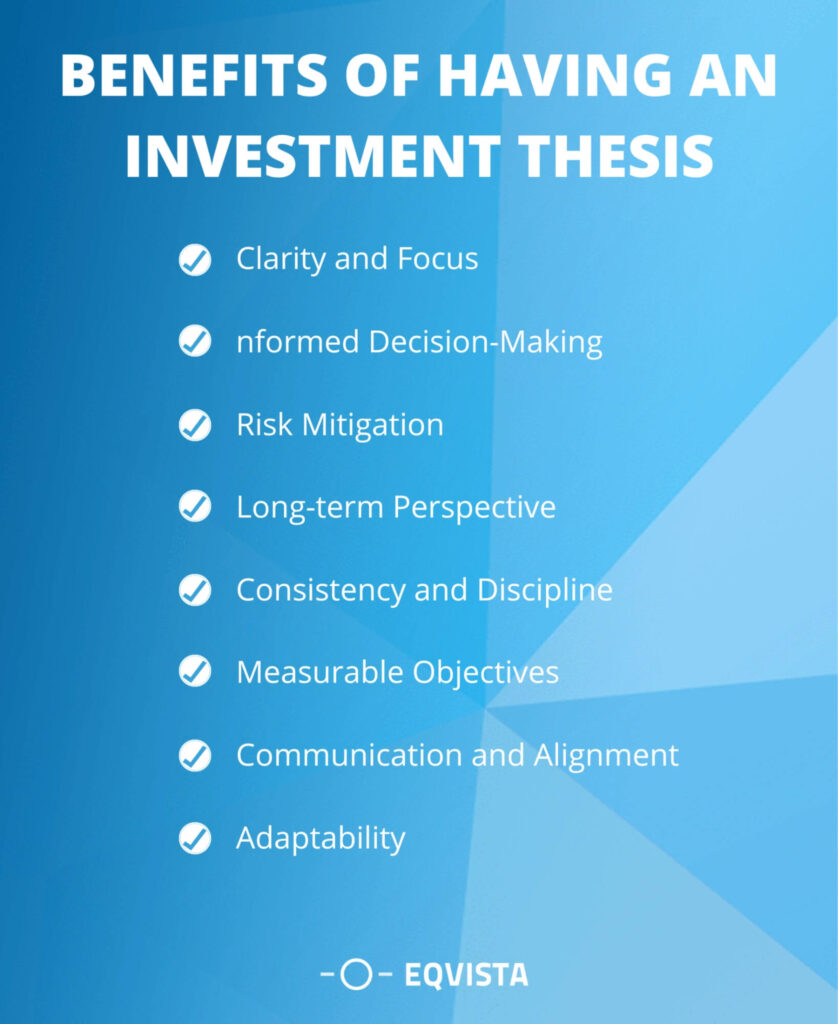Investment Thesis
The investment thesis is a crucial component of every stock presentation. So, what are the components and how does one create a strong investment thesis?
Investing without sound reason is perhaps the best way to characterize chaos in the venture capital market. That is why most venture capitalists and other investors adhere to an investment thesis when investing. This concept also aids venture capital firms in persuading limited partners that their capital is secure.
The investment thesis is a crucial component of every stock presentation. So, what are the components and how does one create a strong investment thesis? Let’s understand the importance of investment thesis in the article.
Investment Thesis
Making an investment takes time. Formulating an investment thesis is a crucial step that an investor should take before investing in an opportunity. A well-written investment thesis will explain in detail why a certain investment opportunity will likely yield a healthy profit.
What is Investment Thesis?
An investment thesis should essentially focus on the following points:
- The reason behind your ownership of the firm.
- The outcomes you anticipate.
- The aspects of the company that do not appear favorably in the market.
According to many seasoned investors, it’s hard to find something more useful to keep investors focused and mentally honest than this simple practice. The key to effective investing is sticking to simple fundamentals and not getting caught up in the market’s big and little swings.
Example of Successful Investment Thesis
It is common practice for investment firms and portfolio managers to provide details on their investing thesis on their websites. Here are a few such instances.
Morgan Stanley
Among the most prestigious banking institutions in the world, Morgan Stanley (MS) ranks high. It provides wealth management, securities, investment banking, and investment management services. The business claims that its investing method consists of five stages: ideation, evaluation of quality, valuation, management of risk, and portfolio development.
As part of the quality evaluation process, the firm aims to address the following three issues while formulating its investment thesis:
- How vulnerable is the business to revolutionary shifts, and is it a disruptor in its own right?
- Does the firm show signs of solid financial health, such as low capital intensity, low leverage, high margins, and great cash conversion?
- Is the investment thesis vulnerable to risks related to governance, accounting, or social or environmental externalities that the firm does not own?
Why is Investment Thesis important?
An investment thesis is a critical tool for investors that outlines the rationale and framework behind their investment decisions. It serves several important purposes, including:
- Clarity in decision-making – An investment thesis clarifies the decision-making process by establishing a clear framework and criteria for making investment choices. For instance, an investor may have a clear investment thesis centered around renewable energy companies.
- Minimizing risk – This includes a thorough risk assessment and mitigation strategy. Consider an investment thesis for a technology-focused portfolio. The thesis might identify regulatory changes as a potential risk.
- Long-term perspective – An investment thesis encourages a long-term perspective by providing a strategic roadmap. An investor with a long-term outlook may have an investment thesis centered around demographic trends, such as the aging population. The investor can better withstand short-term market swings also.
Key Components of an Investment Thesis
What does a strong investment thesis sample contain? Let’s discuss the crucial components that make up the thesis.

- Thesis Statement – This concise statement outlines the core investment idea, the rationale behind the investment, and the expected outcomes. Specify the market problem or opportunity the technology addresses, emphasizing the pain points and how the innovation uniquely solves them. Highlight the potential transformative impact on industries or user experiences.
- Market Analysis – This is an in-depth examination of the target market, including size, growth potential, trends, and dynamics. Provide a breakdown of target customer segments, their specific needs, and how the technological solution meets them. Include data on market trends, adoption rates, and potential regulatory changes affecting the technology landscape.
- Value Proposition – It is a clear articulation of the investment’s unique value. Describe user scenarios or case studies that illustrate how the technology creates value. Discuss user-centric design principles or usability features that enhance the overall user experience.
- Competitive Advantage – This includes identifying and explaining the factors that set the investment apart from competitors. Conduct a detailed comparative analysis of competitors, emphasizing technical differentiators. Discuss the scalability of the technology and how it positions the investment for long-term success.
- Financial Projections – This is a detailed forecast of the financial performance of the investment over a specific period. Break down financial projections into technical milestones, development costs, and key technical performance indicators. It could involve metrics like software development timelines or manufacturing efficiency improvements.
- Risk Assessment – This is a comprehensive analysis of potential risks and challenges associated with the investment. Evaluate potential technical risks in-depth, including dependencies on specific technologies, potential bottlenecks in the development process, and cybersecurity concerns. Provide mitigation strategies for each identified risk.
- Exit Strategy – This plan outlines how and when investors intend to exit the investment. Detail potential acquirers or partners, emphasizing their strategic interest in the technology. Discuss IP (intellectual property) strategies and how they contribute to the exit plan.
- Management Team – This evaluates the skills, experience, and track record of the management team responsible for executing the business plan. Showcase specific technical accomplishments of the management team members. Highlight their roles in previous successful technology projects and their ability to lead technical teams effectively.
- Social and Environmental Impact (if relevant) – This is a consideration of the investment’s impact on social and environmental factors. Provide a comprehensive assessment of the environmental and social implications of the technology. Discuss any relevant industry certifications or standards highlighting the technology’s positive impact.
- Supporting Evidence – Data, research, and evidence that substantiate the claims made in the investment thesis. Include technical documentation, prototypes, beta testing results, and user feedback. Provide detailed information on the technology’s development roadmap, emphasizing key technical milestones and their corresponding timelines.
Benefits of Having an Investment Thesis
Investment thesis presentation helps businesses in a variety of ways. Here are the most important advantages of this statement.

- Clarity and Focus – An investment thesis provides a clear and concise roadmap for investment decisions, helping investors stay focused on their strategic objectives and avoid distractions from short-term market fluctuations or emotional reactions.
- Informed Decision-Making – Financial decisions with a clear thesis require a systematic framework, in-depth investigation, and established criteria. It guarantees decision-making based on a thorough comprehension of the investing environment.
- Risk Mitigation – Through a comprehensive risk assessment in the investment thesis, investors can proactively identify and mitigate potential risks, minimizing the impact of unforeseen challenges.
- Long-term Perspective – It encourages a long-term perspective, reducing the influence of short-term market fluctuations and promoting strategies aligned with broader, sustained success.
- Consistency and Discipline – A well-defined investment thesis fosters consistency and discipline in investment, preventing impulsive decisions driven by market noise or emotions.
- Measurable Objectives – An investment thesis often includes specific, measurable objectives. It allows investors to track progress, assess performance against predefined benchmarks, and make necessary data-driven adjustments.
- Communication and Alignment – This acts as a communication tool that facilitates alignment among stakeholders, team members, or clients. It clearly articulates the investment strategy, objectives, and rationale, fostering a shared understanding among all involved parties.
- Adaptability – While providing a structured framework, an investment thesis also allows for adaptability. Regular reviews and updates enable investors to incorporate new information, adjust strategies based on market developments, and continuously improve their approach over time.
How to create a strong Investment Thesis?
Creating a strong investment thesis involves a thoughtful and systematic process. Here are key steps to help you develop a robust investment thesis:
Research and analysis
The best way to determine how big of a fund you need is to look at other funds with similar objectives and performance metrics. Also, look into successful funds in various businesses and areas to get a feel for what works. A few places to find additional details about funds are trade journals, social media, and news announcements that funds release after they shut.
Identify and assess potential market, industry, and specific investment risks. It includes financial, operational, regulatory, and macroeconomic risks. Develop strategies to mitigate or manage these risks.
Tailoring to individual goals
After you’ve decided on a budget, you should specify the stage, sector, and geographic area where you intend to make investments. Demonstrating your investment concentration helps you focus on certain industries and phases, attracting limited partners who share your objectives. Additionally, founders who fulfill your criteria will find your fund more easily, while founders who don’t will be less likely to approach you for funding.
Flexibility and adaptability
Financial markets inherently involve uncertainty. Include flexibility in your thesis for future technological developments, shifting market situations, and unanticipated circumstances.
Create a routine to check in on your investment thesis and make any necessary updates. It allows you to incorporate fresh data, reevaluate the market, and fine-tune your approach.
FAQs on Investment Thesis
What should be included in an investment thesis?
While this document has no universally accepted format, many elements are consistent across industries. This typically comprises a proposal substantiated by research and analysis, including:
- Said investment
- What the investment aims to achieve
- How likely it is to succeed, taking into account any relevant trends
- The investment’s possible drawbacks and risks
- Investment expenses, possible profits, and losses
What are the benefits of investment research?
Investment research provides critical insights into financial markets, helping investors make informed decisions. It facilitates risk assessment, identifies market trends, and supports selecting viable investment opportunities. By staying well-informed through research, investors can adapt to changing market conditions, minimize risks, and optimize their investment strategies for long-term success.
How does an investment thesis work?
This is a blueprint for making investment decisions. It involves crafting a clear statement of intent, analyzing the market, assessing risks, and defining a unique value proposition. It guides decision-making, promotes a long-term perspective, and ensures consistency. Essentially, it serves as a comprehensive framework informed approach to portfolio management.
Are there any challenges in making an investment thesis?
Yes, creating an investment thesis poses challenges. Research demands time and expertise, and market uncertainties can affect analyses. Balancing individual goals and risk tolerance requires careful consideration. Additionally, unforeseen events can impact investment strategies.
What are the objectives of an investment thesis in startups?
The objectives of an investment thesis in startups include defining the investor’s strategic focus, outlining criteria for startup selection, and articulating the expected value proposition. The thesis also sets measurable objectives, helps identify startups with high growth potential, and aligns the investment strategy with the investor’s broader portfolio objectives.
Discover the Power of Your Investment Thesis in Action!
By carefully considering and developing a well-researched investment thesis, you can enhance your investment decision-making abilities. It is advisable to draft one before making any investments, but you may also do so for current assets. The investing thesis can help determine if the opportunity supports your thesis and suggests you hold or purchase more or if it’s time for a sale. If you’re planning for your next fundraising round, prepare your research now and draft that perfect investment thesis!
If you’re looking for some amazing prospects to invest in, connect with Eqvista, our Eqvista raise program has listed some notable pre-seed and seed stage companies in the market. Eqvista helps you connect you with qualified founders. To learn more about our services, contact us now!
Interested in issuing & managing shares?
If you want to start issuing and managing shares, Try out our Eqvista App, it is free and all online!